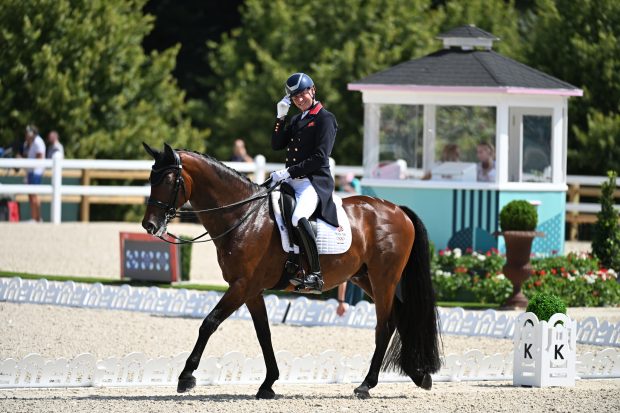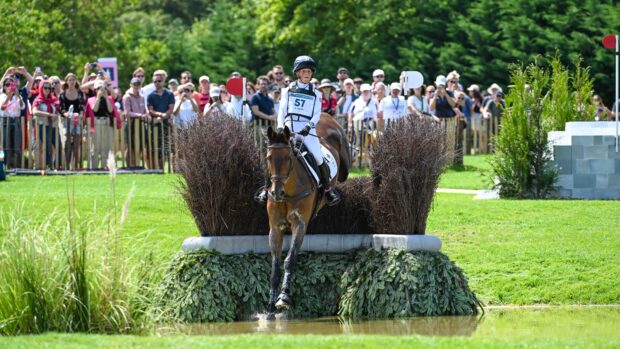Whether you are just starting out in dressage, want to improve your dressage for eventing, or are an experienced dressage competitor, Carl Hester‘s clear and easy to understand advice includes useful tips to help every rider improve their horse’s way of going.
Carl shared his extensive dressage training knowledge and insight with a packed house at the British Dressage national convention at Hartpury this weekend.
H&H dressage editor Alice Collins was at the convention (Read Alice’s blog) and shared Carl’s tips with dressage enthusiasts who were unable to attend via H&H’s twitter. If you missed our tweets, or aren’t on twitter, here are some of the best for you to enjoy.
Warming up
BD convention, Carl Hester: “Obedience to the hand and leg must start in the warm-up”
— Horse & Hound (@horseandhound) November 25, 2012
BD convention, Carl Hester: “If a horse won’t stretch at the beginning of session, work on a contact sooner then stretch when he is ready”
— Horse & Hound (@horseandhound) November 25, 2012
BD convention – Carl Hester: “You should ride about 200 transitions per session – fwd & back to make the horse rideable & on the aids”
— Horse & Hound (@horseandhound) November 24, 2012
Straightness
BD convention – Carl Hester: “Riders blame saddles when the problem is usually that the horse isn’t straight and throws them off to side.”
— Horse & Hound (@horseandhound) November 24, 2012
BD convention, Carl Hester: “If horse isn’t even in both reins don’t keep pulling the heavy one – work to put the weight in the empty rein”
— Horse & Hound (@horseandhound) November 25, 2012
BD convention, Carl Hester: “If horse is stiff on outside rein, use renvers to soften them up and add weight to other rein.”
— Horse & Hound (@horseandhound) November 25, 2012
BD convention – Carl Hester: “Everybody should have to ride quarter lines – they show if the horse is contained in the outside aids.”
— Horse & Hound (@horseandhound) November 24, 2012
Improving paces
BD convention, Carl Hester: “The only way to improve/influence horses’ paces is to ride forward in a balanced way.”
— Horse & Hound (@horseandhound) November 25, 2012
BD convention, Carl Hester: “The trot is the easiest page to change & improve but you need to buy a good walk and a good canter”
— Horse & Hound (@horseandhound) November 25, 2012
BD convention, Carl Hester: “Use half transitions to bring a horse back in trot and teach him to wait in balance rather than full half-halt”
— Horse & Hound (@horseandhound) November 25, 2012
BD convention – Carl Hester: “Use lots of forwards and back transitions within the canter to spice up the hindleg”
— Horse & Hound (@horseandhound) November 24, 2012
BD convention – Carl Hester: “Half-halts are invisible – or should be – that’s why they’re so hard to explain. It’s what works for you.”
— Horse & Hound (@horseandhound) November 24, 2012
Strong/tense horses
BD convention, Carl Hester: “If horse is strong, don’t go in straight lines, circle & circle until he’s not pulling & is balancing himself”
— Horse & Hound (@horseandhound) November 25, 2012
BD convention, Carl Hester: “A tense horse’s lateral suppleness can be improved by very forward canter leg yields.”
— Horse & Hound (@horseandhound) November 25, 2012
Other useful tips
BD convention, Carl Hester: “For lateral work always remember to sit on your inside seatbone.”
— Horse & Hound (@horseandhound) November 25, 2012
BD convention, Carl Hester: “Horses in self-carriage will get tired esp if not used to holding themselves so intersperse with stretching”
— Horse & Hound (@horseandhound) November 25, 2012
BD convention, Carl Hester: “If you carry a whip just to make your horse go, you shouldn’t carry one. They are just for small corrections.”
— Horse & Hound (@horseandhound) November 25, 2012
BD convention, Carl Hester: “It doesn’t matter what type of horse you have, you can teach it square halts – they’re ‘free’ marks.”
— Horse & Hound (@horseandhound) November 25, 2012




